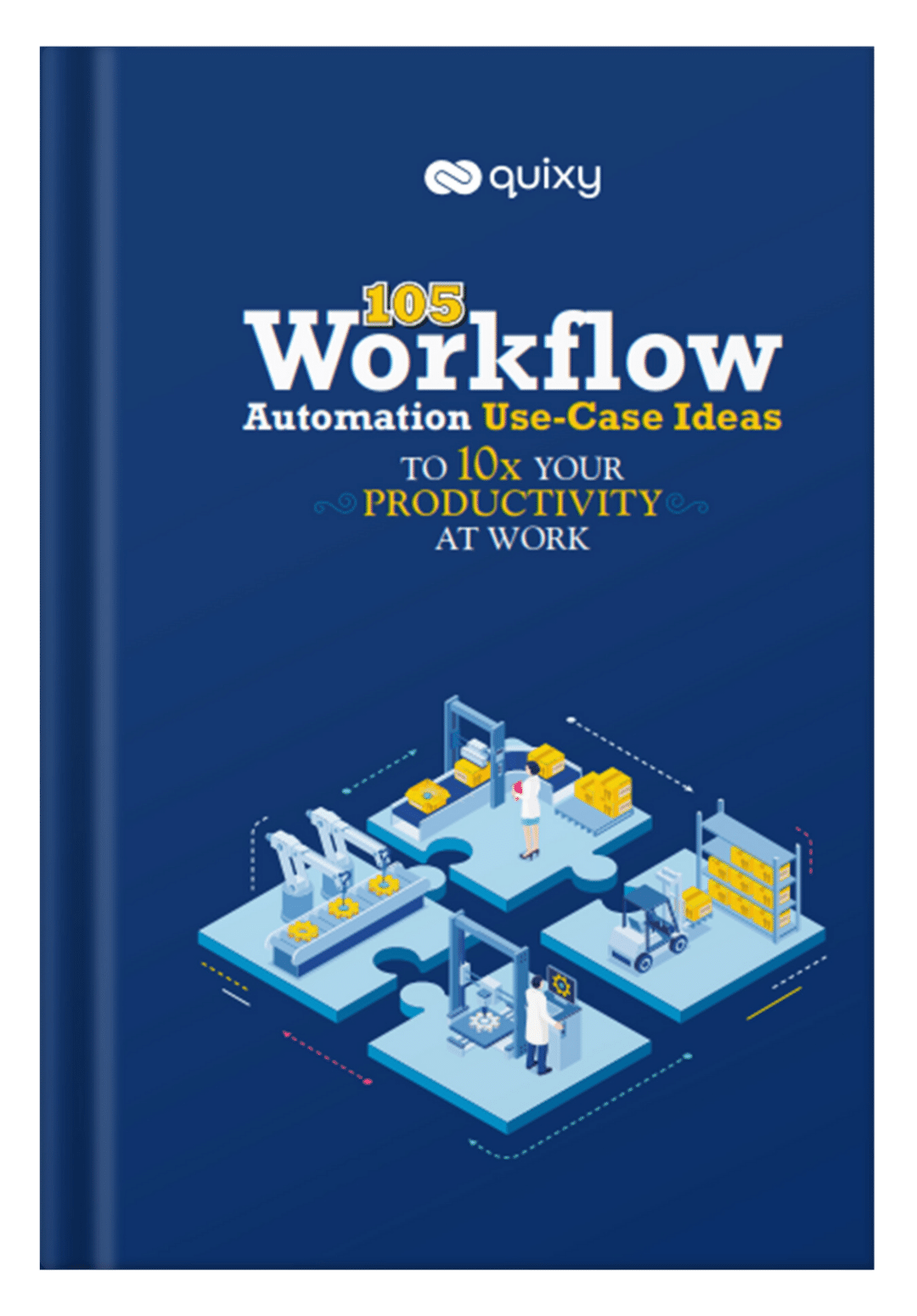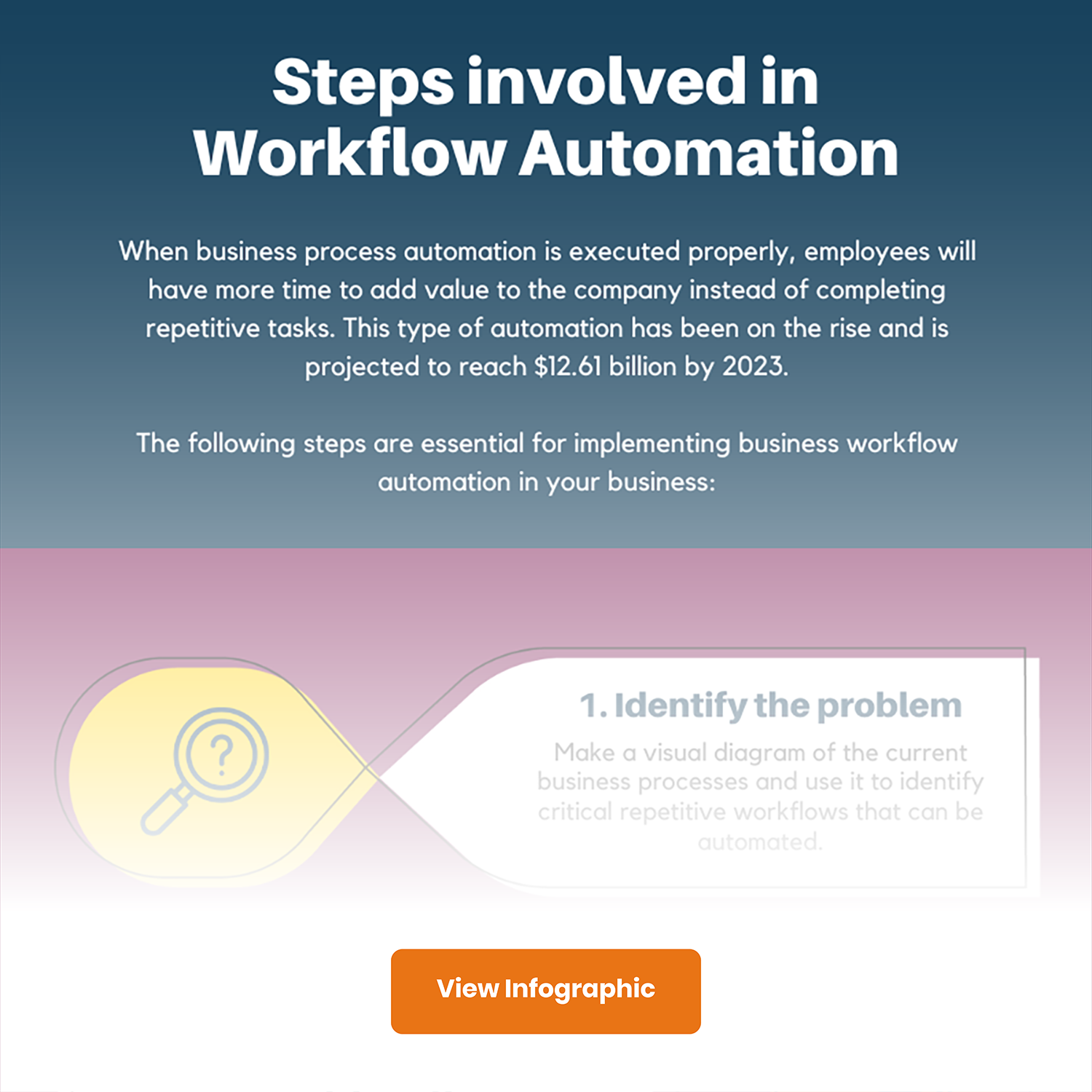09 Aug

Ever heard about Workflow Automation software? What is it? Why should you care? What are the benefits? Don’t worry !! We’ll cover them all in this brief guide on workflow automation. Let’s get started.
The world is evolving rapidly, with customers becoming more used to quick services and expecting perfection at every point. It doesn’t matter to the customers whether you are a multinational company or startup because people expect you to deliver with speed and quality in everything you do.
Business process management and workflow automation is one approach every business takes to remove bottlenecks and inefficiencies from their business processes, thereby significantly cutting down the time and cost of delivering products or services. According to a market research study, the SME segment alone is expected to spend more than $1.6 billion in workflow automation software during 2017-2026.
Let’s start with the basics.
What is a Workflow?
A workflow is a series of sequential tasks that are carried out to execute a business process.
An example of a very simple workflow would be a leave application process. In this workflow an employee applies for leave, the manager approves it, and then HR processes it.
When leaving the company, a little more complex workflow can be an employee clearance process. In this case, the manager initiates the clearance, which is then routed to different departments like Admin, IT, HR and only after all clearances are obtained the workflow moves to the accounts department for full and final settlement.

What is Workflow Automation?
Workflow automation is an approach that streamlines and optimizes business processes by utilizing technology to automatically route tasks and information between systems and business users in the organization. With workflow automation, businesses can save time, increase efficiency, and reduce errors by eliminating manual, repetitive tasks and ensuring consistency in their workflows. By implementing workflow automation solutions, companies can achieve greater productivity, cost savings, and overall success in their operations.
Also Read: Workflow vs Process: What are the Key Differences?
When does it make sense to use Workflow Automation?
Any automation requires time and money. So it would make sense to take it up only when benefits outnumber the costs involved. Also, you can evaluate automation feasibility: Use thought-provoking questions to gauge if your processes are ready for automation with our automation maturity assessment guide.
So it would make sense to take up workflow automation only when:
- the tasks are repetitive. It would not make sense to automate a workflow that is not repetitive or occurs only occasionally.
- the workflow is critical where tasks must be achieved accurately and efficiently, eliminating chances of any human error and delay.
- automation can bring out significant improvement in the time of execution or quality of the output.
Hopefully, by now, we are convinced of the importance of workflow automation. So now let’s see how we can put it into action.

6 steps involved in Workflow Automation

1. Set Goals
The first and most critical step is to set the goals for automation. You must ensure that these goals are SMART, i.e., specific, measurable, attainable, relevant, and time-based. It could be the increased ROI, faster time to reach market demands, or increased team productivity.
Clearly define the goals..!
2. Identify repetitive workflows
The next step would be to identify workflows that, when automated, can lead you to your set goals. The best way to identify these is by making a visual diagram of the current business processes and using it to identify critical repetitive workflows that you believe are hindering you from achieving your goals.
Identify areas for immediate attention, gain unparalleled insights, supercharge productivity, cut costs, and accelerate growth with the automation report card.

3. Choose the right automation tool
Now that you have identified your goals and the workflows, the next step would be to select the top workflow automation software. A few factors to consider here would be the cost, ease of use, operations, and maintenance, proven track record, etc
4. Train the users
Next you would have to train the workforce to use the new automation workflow tool. Providing a simple transition path from the current manual process to the new automated system and providing them with sufficient training will go a long way toward making this transformation a success.

5. Measure key performance indicators
After completing the above steps, you are up and running on your new fully automated workflow system. Your customers, who might be your own employees, will provide feedback on the new automated process based on their experience. It is important to consider their views and suggestions to improve customer satisfaction.
Continuous monitoring and measuring of your newly upgraded workflow will help your team become more efficient.
Also Read: Online License Management System for Businesses : From Paperwork to Progress
6. Make changes to improve
This means continuously evaluating and improving the process to make it more efficient, effective, and/or streamlined. This can be achieved by identifying areas of the process that may be causing delays or bottlenecks and then making adjustments to address those issues. It also means regularly gathering feedback from those involved in or impacted by the process and using that feedback to make further improvements. Additionally, keeping an eye on industry best practices and incorporating them into the process can help improve its improvement.
Now that we have implemented enterprise workflow automation let’s look at the possible benefits we might have achieved. Is it only time and cost savings or something more? Let’s explore

Top 5 benefits of workflow automation

1. Streamlines communication
Workflow automation improves communication between the stakeholders involved in the workflow. This may be your employees, vendors, or customers. For example, once you have automated your complaint-handling process through a self-service portal, customers may get access to the up-to-date status of their complaint without having to write an email or call you, thereby streamlining communication.
2. Creates accountability
One person is designated to perform a specific task for each step in the workflow process. By adopting this you are creating a system of accountability where everyone knows what specific tasks they are responsible for. Every person involved in the process is held accountable for his or her specific task.
Also Read: 10 Automation Mistakes That Must Be Avoided
3. Reduces costs and eliminates errors
Automation eliminates errors from manual processes and saves operational costs. Imagine manual entry of insurance claims received from customers in the form of paper-based files. Compare this to an automated workflow where the customer enters the claim information themselves in an online claim system, and the agent only verifies that all necessary documentation is attached. You can visualize the savings in costs and possible errors.
Quixy’s workflow automation can cut request and approval cycle times in process workflows by more than half and significantly reduce costs. To help you calculate the possible savings, use any of the calculators below to estimate your current costs and potential savings.

4. Creates transparency at each step
Workflow automation provided real-time single window access to all the data from the automated workflows. You can see what tasks are at what stage or who they are currently assigned to. You can easily identify the bottlenecks and work on eliminating them.
5. Provides actionable insights
Reports and dashboards can be built on top of data collected from the automated workflows, providing actionable insights into the operations. The data can also be used to make intelligent projections and forecasts.
Also read: Top 9 Benefits of Workflow Automation that you can not deny!
Now let’s look at some examples
Top 5 Examples of workflow automation
Workflow automation is easy to accomplish and can boost processes you’ve never thought of improving before.
Here are 5 examples of workflow automation that are expected to make life easier.

1. Purchase orders
Purchase orders are repetitive tasks that can benefit from automation. Typically, an employee with a requirement fills out a requisition and sends it to the purchasing department. The purchase manager reviews the request and may approve or reject it. If rejected, the request is sent back to the requester. If approved, a purchase order is issued. Similarly, invoices also follow a workflow that can benefit from automation.
2. Leave requests
In this case, an employee fills in a leave application. The manager reviews the application and then approves or rejects it. If rejected, the employee is notified. The HR team is informed if approved and then processes the application.
3. Expense reimbursements
An employee initiates a reimbursement claim by filling out a form and sending it to the manager. The form is sent back to the employee in case of any clarifications. If approved, the form is forwarded to the accounts department. The accounts officer verifies all details and then processes the claim for reimbursement. The employee is intimated.
4. Content approvals
Anyone in the marketing team initiates a content request with a topic and a brief description. The editor reviews the topic to check for alignment with content strategy and then sends it to the SEO expert. The SEO expert suggests keywords be targeted in the content. The request, along with the input from the SEO expert, is assigned to a content writer. The writer completes a draft and sends it to a designer for visual elements. Once done, the output is shared with the editor. The editor either approves it or sends it back to the writer or designer for changes. Once approved, the content is published.
Also Read: Automating your Content Marketing Workflow is a walk in the park with Quixy
5. Task Management
A manager creates a task for a team member and assigns a priority and due date. The task is routed to the assigned employee. If any clarifications were required, the team member asked the manager to provide more clarity. Once done, the team member resolves the task. After verifying the output, the manager closes or re-opens the task.
Free Download: Workflow Use Cases
Workflow Use Cases give you an idea of what’s possible with workflow automation tools. This downloadable resource includes a wide variety of workflow examples that show numerous ways users across departments in any organization can use automation to improve business processes and increase efficiency.
Also Read: Achieving Efficiency Amid Automation Challenges: Expert Tips
Conclusion
Every business is seeking efficiency in its processes to meet the stakeholder requirements. If executed effectively, workflow automation can provide huge benefits toward this goal. By automating, companies save time and reduce the risk of manual errors enabling them to deliver faster and better services.
Quixy is among the top no-code business process management platforms that can be used to automate any workflows 10X faster compared to traditional approaches. It is also extremely easy to use. Get started with our platform, and experience the ease of automated processes and personalized app building.
Frequently Asked Questions
In this FAQ section, we’ll answer some common questions about workflow automation software to help you get started.
Q. What are the benefits of using workflow automation software?
The benefits of using workflow automation software are numerous. It can improve efficiency by reducing manual errors, optimizing resource allocation, and providing real-time visibility into process performance, leading to better decision-making. It can also enhance collaboration, streamline communication, reduce costs, and increase productivity by automating repetitive tasks and freeing your time for more strategic activities.
Q. How can workflow automation software improve productivity and efficiency in the workplace?
Workflow automation software can improve productivity and efficiency in the workplace by eliminating manual tasks, minimizing errors, & allowing employees to emphasize more on important and strategic activities. It can also speed up processes, provide real-time insights into performance, and facilitate communication and collaboration between team members.
Q. Can workflow automation software integrate with other business applications and tools?
Workflow automation software can integrate with other business applications and tools, such as CRM systems, marketing automation platforms, project management tools, and HR management systems. This integration allows for seamless data transfer and collaboration between different tools, streamlining operations and reducing the need for manual intervention.
Q. What factors should be considered when selecting workflow automation software?
When selecting workflow automation software, it’s crucial to consider a few factors, such as ease of use, scalability, pricing, customization options, security, and integration capabilities. You should also evaluate your business needs and goals to ensure the software meets your requirements.
Q. Can workflow automation software be customized to meet specific business needs?
Yes, workflow automation software can be customized to meet specific business needs. Many tools offer customization options, such as custom workflows, fields, and integrations, allowing businesses to tailor the software to their unique requirements.
Q. What are some successful implementation examples of workflow automation software in businesses?
Many successful examples of workflow automation software implementation in businesses include using automation to streamline HR onboarding, automate sales processes, and optimize marketing campaigns. These implementations have increased efficiency, reduced costs, and improved productivity, among other benefits. You can also read our blog Quixy using Quixy to learn how our in-house team uses our platform Quixy to streamline their workflow in day-to-day tasks.
Subscribe
Login
Please login to comment
0 Comments













